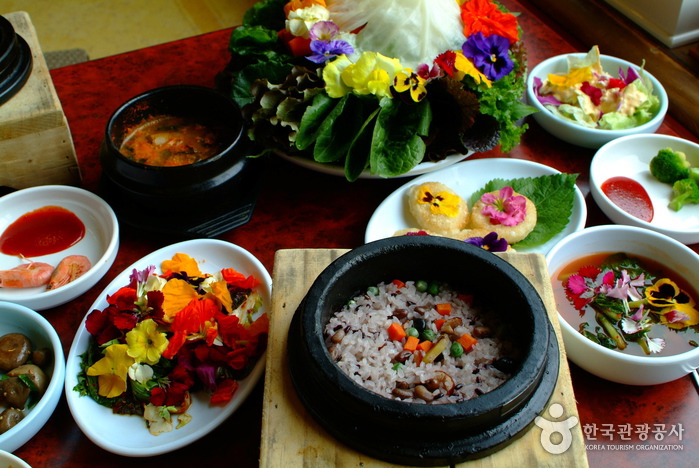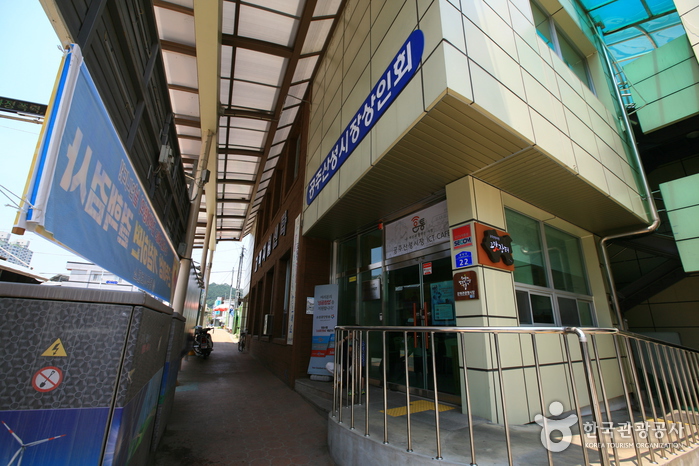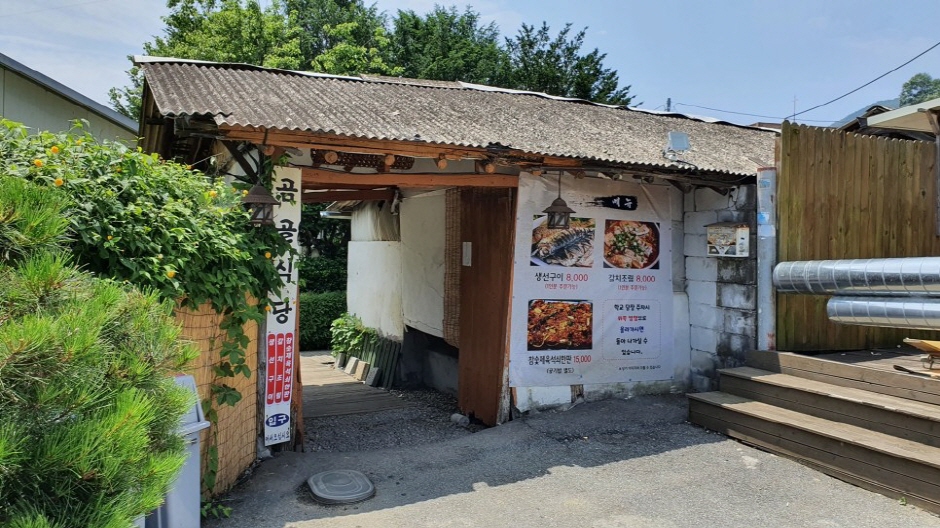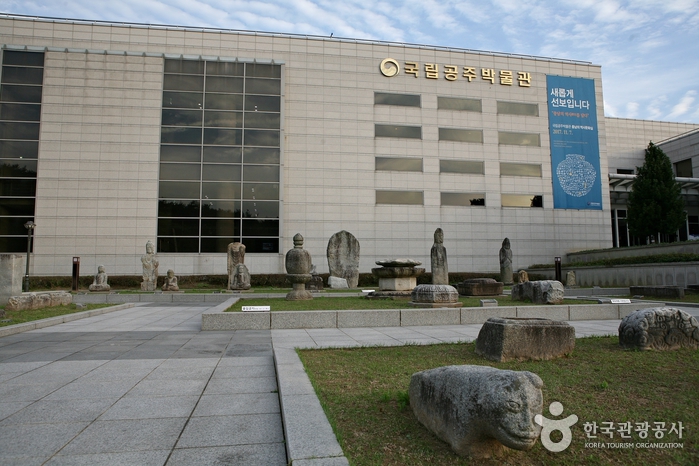Gongju Gongsanseong Fortress [UNESCO World Heritage] (공주 공산성 [유네스코 세계문화유산])
0m 42027 2024-03-15
280 Ungjin-ro, Gongju-si, Chungcheongnam-do
+82-41-856-7700
Gongsanseong Fortress is a fortification situated at the heart of Gongju, which served as the capital of the ancient Baekje kingdom (18 BCE - 660 CE) from 475 to 538. Even after Baekje's fall, subsequent dynasties such as Silla (57 BCE - 935 CE), Goryeo (918-1392), and Joseon (1392-1897) continued to use Gongju as a regional administrative center. As a result, numerous historical sites have accumulated in the area over time. From the fortress, visitors can enjoy a panoramic view of Gongju’s city center and the Geumgang River.
Guard-Changing Ceremony of Woongjinseong Fortress (웅진성수문병 근무교대식)
370.89489754687634m 2090 2022-12-21
280, Woongjin-ro, Gongju-si, Chungcheongnam-do
• 1330 Travel Hotline: +82-2-1330 (Korean, English, Japanese, Chinese) • For more info: +82-41-856-7700
The Guard-Changing Ceremony of Woongjinseong Fortress takes place at Gongsanseong Fortress, a part of the Baekje Historic Areas which is a desginated UNESCO's World Heritage Site. The ceremony reenacts the service of the guards defending the castle, using costumes and props based on the strict analysis of the historical records. The ceremony is held every Saturday and Sunday from April to November except during hot summer season of June to August, and conducted every day during the Baekje Culture Festival in the fall. The event includes martial art performances and various experiences as well as the main ceremony, aiming at promoting Gongju-si, where the Baekje culture flourished, and its valuable heritage Gongsanseong Fortress.
Gomanaru 1999 (고마나루1999)
388.4633677098826m 8873 2024-02-28
5-8 Baengmigoeul-gil, Gongju-si, Chungcheongnam-do
+82-41-857-9999
Gomanaru 1999 is a Korean restaurant located near Gongsanseong Fortress. Their menu features a single set meal called gomanaru bapsang (rice and side dishes), which includes a hearty spread of pot rice, boiled pork slices, grilled marinated pork shoulder, and grilled dried pollack. Using rice from Gongju, the rice is flavorful and nourishing, complemented by fresh vegetables from Jirisan Mountain, making for a healthy meal. Rice is considered a staple in Korean cuisine, and Jirisan Mountain is renowned as a pristine region, making the food here particularly special.
HONG WHI KWAN[Korea Quality] / 홍휘관[한국관광 품질인증/Korea Quality]
477.1864479458555m 139 2020-11-19
6-6, Baengmigoeul-gil, Gongju-si, Chungcheongnam-do
+82-10-9701-3141, +82-41-858-8890
Located in Gongju, South Chungcheong Province, Hongwhikwan offers guests a traditional “hanok” experience filled with the gentle scents of red clay and wood. The hotel is located in front of the UNESCO World Heritage site Gongsanseong Fortress, with Geumgang River flowing behind the complex.
There are six rooms in total, all Korean-style with floor bedding for double, triple, and quadruple occupancy. High ceilings and exposed girders greet visitors upon entering the rooms that are decorated with traditional bedding, Korean paper windows, elegant muslin curtains, and colorful cushions. Each room is equipped with a TV set, a refrigerator, and a bathroom with a hairdryer, making it an ideal place to start and end the day. The spacious courtyard also comes with traditional games like “jegi chagi” and “yutnori.” Coffee and Korean tea are found in the second-floor community room, while the kitchen serves complimentary breakfast every morning with a simple menu of toast, beverages, fruits, and breakfast cereals. Furthermore, the complex is close to major tourist sites, such as the Gongjusanseong Market, Gongju National Museum, the UNESCO World Heritage site Ancient Tombs in Songsan-ri, and Tomb of King Muryeong. Hongwhikwan also offers free bicycle rentals for guests to stroll around the location.
Gongju Sanseong Market (공주산성시장)
592.1293439103496m 1 2024-01-08
22 Yongdang-gil, Gongju-si, Chungcheongnam-do
Opened in 1937, this expansive market features a variety of items across its five sections. It’s conveniently located near tourist attractions like Gongju National Museum, Gongsanseong Fortress, and Tomb of King Muryeong. The arcade-style roof allows for comfortable exploration in any weather or season. The Food Alley offers an irresistible selection of local delicacies, making it hard to choose from options like gimbap, banquet noodles, and bulgogi. Not to be missed are Gongju’s specialties: chestnut makgeolli (rice wine) and chestnut sweet rice cake, made from local chestnuts. The Bammasil Night Market, a summer weekend highlight, combines cultural performances and traditional games with a vast array of foods, all enjoyed against the backdrop of a stunning sunset.
Mireuseom Island (미르섬)
812.3106925010767m 0 2023-10-27
368 Geumbyeok-ro, Gongju-si, Chungcheongnam-do
Mireuseom Island is covered in a blanket of beautiful plants every fall, from cosmos to pink muhly, broom cypress and pearl millet. The pink muhly growing along the Geumgang River is a popular photo spot. The beautiful landscape unfolds the longer you walk towards Gongjudaegyo Bridge.
Gongju Tomb of King Muryeong and Royal Tombs [UNESCO World Heritage] (공주 송산리 고분군과 무령왕릉 [유네스코 세계문화유산])
1.1 Km 33941 2024-01-08
37-2 Wangreung-ro, Gongju-si, Chungcheongnam-do
The Songsan-ri Tombs and Royal Tomb of King Muryeong (r. 462-523) contain representative relics of the Baekje period (234-678). The Songsan-ri Tombs contain the graves of kings from the period when Baekje's capital was Gongju, and it is believed to contain 17 such graves. Only seven graves have been discovered so far. There are two types of tomb designs: traditional Baekje-style rock and earth fortification tomb and Chinese-influenced rock tomb. The tombs number one to five were made using the traditional Baekje-style design while tomb number six and the Royal Tomb of King Muryeong were made using the Chinese-influenced design. Even though many artifacts were stolen from the tombs, the tombs serve as an important evidence of Baekje culture and the foreign exchanges from during that period.
Himart - Gongju Branch [Tax Refund Shop] (하이마트 공주점)
1.2 Km 0 2024-04-18
51, Beonyeong 1-ro, Gongju-si, Chungcheongnam-do
-
Restaurant Gomgol (곰골식당)
1.4 Km 0 2024-01-09
1-2 Bonghwangsan 1-gil, Gongju-si, Chungcheongnam-do
This renowned restaurant in Gongju is always bustling. Upon passing through its old, time-honored main gate, one is greeted by a tastefully minimalist garden leading to the eatery itself. The restaurant boasts a carefully selected main menu, offering just three specialty dishes: charcoal-grilled spicy pork, grilled fish, and braised cutlassfish. Each meal is accompanied by an abundant array of ssam (wrap) vegetables and delicious side dishes, available for unlimited refills at the self-service bar. The charcoal-grilled spicy pork is expertly cooked for immediate enjoyment, without the need for diners to grill it themselves. The smoky aroma of the charcoal complements the subtle seasonings perfectly. The grilled fish offers a delightful contrast with its crispy skin and succulent flesh. An additional perk is the option to order single servings of all menu items.
Gongju National Museum (국립공주박물관)
1.4 Km 22986 2021-05-20
34, Gwangwangdanji-gil, Gongju-si, Chungcheongnam-do
+82-41-850-6300
Gongju National Museum preserves and displays cultural treasures, as well as provides educational programs for locals. The museum collection includes over 10,000 relics, including 19 National Treasures and three Treasures, all excavated from the Chungcheongnam-do & Daejeon areas. The most important of these artifacts are displayed permanently, while the remaining items rotate with special exhibitions. In front of the main building is a garden visitors can enjoy after touring the museum.
![Gongju Gongsanseong Fortress [UNESCO World Heritage] (공주 공산성 [유네스코 세계문화유산])](http://tong.visitkorea.or.kr/cms/resource/75/2678675_image2_1.jpg)


![HONG WHI KWAN[Korea Quality] / 홍휘관[한국관광 품질인증/Korea Quality]](http://tong.visitkorea.or.kr/cms/resource/57/2651357_image2_1.jpg)

![Gongju Tomb of King Muryeong and Royal Tombs [UNESCO World Heritage] (공주 송산리 고분군과 무령왕릉 [유네스코 세계문화유산])](http://tong.visitkorea.or.kr/cms/resource/95/2678695_image2_1.jpg)
![Himart - Gongju Branch [Tax Refund Shop] (하이마트 공주점)](http://tong.visitkorea.or.kr/cms/resource/43/2883343_image2_1.jpg)


 English
English
 한국어
한국어 日本語
日本語 中文(简体)
中文(简体) Deutsch
Deutsch Français
Français Español
Español Русский
Русский